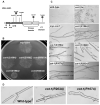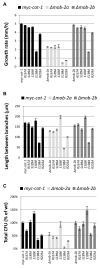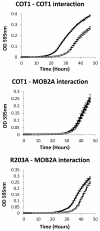The N-terminal region of the Neurospora NDR kinase COT1 regulates morphology via its interactions with MOB2A/B
- PMID: 23962317
- PMCID: PMC4603829
- DOI: 10.1111/mmi.12371
The N-terminal region of the Neurospora NDR kinase COT1 regulates morphology via its interactions with MOB2A/B
Abstract
Nuclear Dbf2p-related (NDR) protein kinases are important for cell differentiation and polar morphogenesis in various organisms, yet some of their functions are still elusive. Dysfunction of the Neurospora crassa NDR kinase COT1 leads to cessation of tip extension and hyperbranching. NDR kinases require the physical interaction between the kinase's N-terminal region (NTR) and the MPS1-binding (MOB) proteins for their activity and functions. To study the interactions between COT1 and MOB2 proteins, we mutated several conserved residues and a novel phosphorylation site within the COT1 NTR. The phenotypes of these mutants suggest that the NTR is required for COT1 functions in regulating hyphal elongation and branching, asexual conidiation and germination. Interestingly, while both MOB2A and MOB2B promote proper hyphal growth, they have distinct COT1-dependent roles in regulation of macroconidiation. Immunoprecipitation experiments indicate physical association of COT1 with both MOB2A and MOB2B, simultaneously. Furthermore, the binding of the two MOB2 proteins to COT1 is mediated by different residues at the COT1 NTR, suggesting a hetero-trimer is formed. Thus, although MOB2A/B may have some overlapping functions in regulating hyphal tip extension, their function is not redundant and they are both required for proper fungal development.
© 2013 John Wiley & Sons Ltd.
Figures







Similar articles
-
Two NDR kinase-MOB complexes function as distinct modules during septum formation and tip extension in Neurospora crassa.Mol Microbiol. 2009 Nov;74(3):707-23. doi: 10.1111/j.1365-2958.2009.06896.x. Epub 2009 Sep 28. Mol Microbiol. 2009. PMID: 19788544 Free PMC article.
-
Altering Neurospora crassa MOB2A exposes its functions in development and affects its interaction with the NDR kinase COT1.Mol Microbiol. 2018 Jun;108(6):641-660. doi: 10.1111/mmi.13954. Epub 2018 Apr 19. Mol Microbiol. 2018. PMID: 29600559
-
Hydrophobic motif phosphorylation coordinates activity and polar localization of the Neurospora crassa nuclear Dbf2-related kinase COT1.Mol Cell Biol. 2012 Jun;32(11):2083-98. doi: 10.1128/MCB.06263-11. Epub 2012 Mar 26. Mol Cell Biol. 2012. PMID: 22451488 Free PMC article.
-
Conidiation in Neurospora crassa: vegetative reproduction by a model fungus.Int Microbiol. 2020 Jan;23(1):97-105. doi: 10.1007/s10123-019-00085-1. Epub 2019 Jun 6. Int Microbiol. 2020. PMID: 31172300 Review.
-
Mammalian NDR protein kinases: from regulation to a role in centrosome duplication.Biochim Biophys Acta. 2008 Jan;1784(1):3-15. doi: 10.1016/j.bbapap.2007.07.017. Epub 2007 Aug 15. Biochim Biophys Acta. 2008. PMID: 17881309 Review.
Cited by
-
Identification and manipulation of Neurospora crassa genes involved in sensitivity to furfural.Biotechnol Biofuels. 2019 Sep 4;12:210. doi: 10.1186/s13068-019-1550-4. eCollection 2019. Biotechnol Biofuels. 2019. PMID: 31508149 Free PMC article.
-
The GUL-1 Protein Binds Multiple RNAs Involved in Cell Wall Remodeling and Affects the MAK-1 Pathway in Neurospora crassa.Front Fungal Biol. 2021 Apr 16;2:672696. doi: 10.3389/ffunb.2021.672696. eCollection 2021. Front Fungal Biol. 2021. PMID: 37744127 Free PMC article.
-
Neurospora crassa protein arginine methyl transferases are involved in growth and development and interact with the NDR kinase COT1.PLoS One. 2013 Nov 19;8(11):e80756. doi: 10.1371/journal.pone.0080756. eCollection 2013. PLoS One. 2013. PMID: 24260473 Free PMC article.
-
Cross Talk between Calcium and Reactive Oxygen Species Regulates Hyphal Branching and Ganoderic Acid Biosynthesis in Ganoderma lucidum under Copper Stress.Appl Environ Microbiol. 2018 Jun 18;84(13):e00438-18. doi: 10.1128/AEM.00438-18. Print 2018 Jul 1. Appl Environ Microbiol. 2018. PMID: 29678914 Free PMC article.
-
The Neurospora crassa PP2A Regulatory Subunits RGB1 and B56 Are Required for Proper Growth and Development and Interact with the NDR Kinase COT1.Front Microbiol. 2017 Sep 5;8:1694. doi: 10.3389/fmicb.2017.01694. eCollection 2017. Front Microbiol. 2017. PMID: 28928725 Free PMC article.
References
-
- Bichsel SJ, Tamaskovic R, Stegert MR, Hemmings BA. Mechanism of activation of NDR (nuclear Dbf2-related) protein kinase by the hMOB1 protein. J Biol Chem. 2004;279:35228–35235. - PubMed
-
- Buhr TL, Oved S, Truesdell GM, Huang C, Yarden O, Dickman MB. A kinase-encoding gene from Colletotrichum trifolii complements a colonial growth mutant of Neurospora crassa. Mol Gen Genet. 1996;251:565–572. - PubMed
-
- Chan EH, Nousiainen M, Chalamalasetty RB, Schafer A, Nigg EA, Sillie HH. The Ste20-like kinase Mst2 activates the human large tumor suppressor kinase Lats1. Oncogene. 2005;24:2076–2086. - PubMed
Publication types
MeSH terms
Substances
Grants and funding
LinkOut - more resources
Full Text Sources
Other Literature Sources
Miscellaneous

